Hart Hill
Hart Hill is an area of Buile Hill Park, Salford located at the junction of today’s Weaste Lane and Eccles Old Road. Much of what we know about Hart Hill dates from the late eighteenth century, recorded in newspapers, census data, land tax records and sparse written accounts. The history of Hart Hill, to date, is fragmentary but is enlivened by of a series of interesting residents and their families whose biographies can be found on the People pages.




Hart Hill in June 2019 (above). The 22 acre estate was purchased by Salford in 1925 but only officially opened in 1938 when it became part of Buile Hill park.
The richest historical evidence dates from the 1780s to 1922 when a succession of wealthy and influential families lived on the Hart Hill estate, attracted by the healthy aspect and areas of pasture and meadow which provided stabling, fruit, vegetables and dairy produce. Hart Hill’s location on the turnpike road just 3 miles from Manchester provided an attractive environment for the merchant class and their families, a respite from the bustle of Manchester’s industrial and commercial areas. The nearby parish church of St Mary, Eccles provided the spiritual needs for affluent landowners, a developing business class, yeoman farmers and those working on the land whether it be in subsistence farming or early textile processing. A description of the area in the 1770s by Edward Cropper Percival in his reminiscences of his father Thomas Percival gives a picture of Hart Hill 245 years ago.
In the year of 1775, Dr Percival was induced, for the purposes of health, and for the pleasure of occasional retirement to take a country residence in the neighbourhood of Manchester. The situation which he fixed upon was rendered agreeable by the beauty and fertility of the surrounding country and was distant only a few miles from the town. In this retreat he passed the summer months of many successive years…….. his relish for the quiet and the beauty of the rural scenery was a lively source of gratification…… the fruit during the first summer of his residence at Hart Hill was the publication of a small work….. Moral Tales, Fables and Reflections.
By 1844 the area had developed into one of ‘detached villas situated in the midst of gardens and parks in the country’ approached by ‘one great thoroughfare from Pendleton lined with shops and grocers’. Manchester in 1844, L Faucher
Until 1925 Hart Hill was a distinct private estate, originally part of Fitzgerald land in Pendleton. Eventually covering 22 acres it was bought by Salford Corporation and combined with Buile Hill Park in 1925. For a short period after 1925 the title ‘Hart Hill’ lingers on in the local newspapers but once the area is absorbed into the Buile Hill park the name largely disappears from the locality. Awareness of Hart Hill is only resurrected by two archaeological investigations in 2013 and 2015 which reveal the main house and ancillary buildings and reignite interest in this historic area of Pendleton.
The houses It is possible that there have been at least three houses at Hart Hill. The earliest written reference to Hart Hill dates from 1634 when Mary, daughter of Robert Bradshaw of Hartshill was baptised at St Mary’s, Eccles. Over the next 94 years the parish registers include ‘Hartshill’ to denote the residence of various families, notably the Bradshaws, but also Ralph Barlow whose burial took place at Eccles in 1655. In 1728 Robert, son of Ralph Bradshaw of Hartshill was also baptised at Eccles.
A second house probably dates from the the mid-eighteenth century. There are no images of this house*, which would have also included outbuildings such as barns, stables, shippons and estate cottages, but we do have a single description which describes the building as a ‘charming stuccoed house’. Whether this was an adaptation of an earlier house or a completely new building is unknown. This was probably the house lived in by Thomas Percival, George Wakefield, the Simpson family and Thomas Trueman. A map of 1815 shows the location of Hart Hill and the name of its occupant, ‘Simpson esq’. This house survived until 1855 when the Hart Hill estate and its house was bought by James Dugdale who demolished the earlier house to make way for an impressive new mansion.

*In January 2021 an image of the second Hart Hill house (above) was published at https://library.chethams.com/from-home/the-manchester-scrapbook/ The link also includes images of other local houses with brief descriptions.
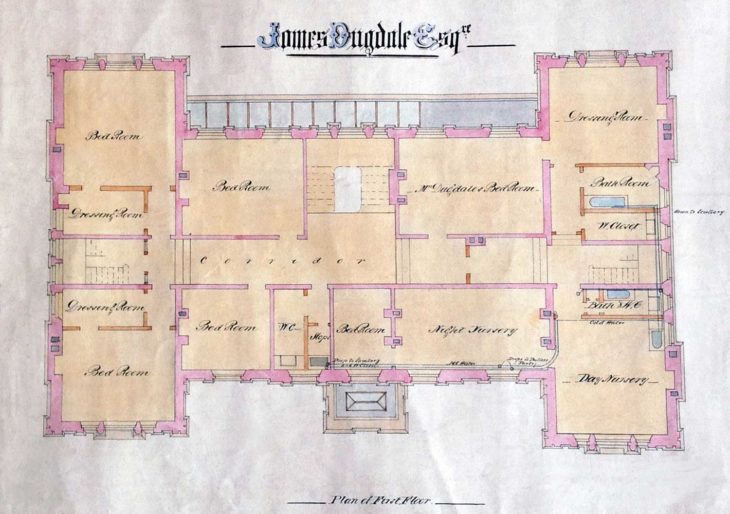
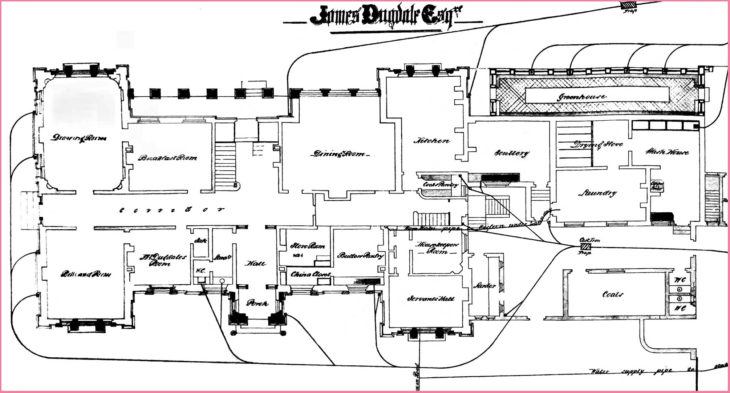
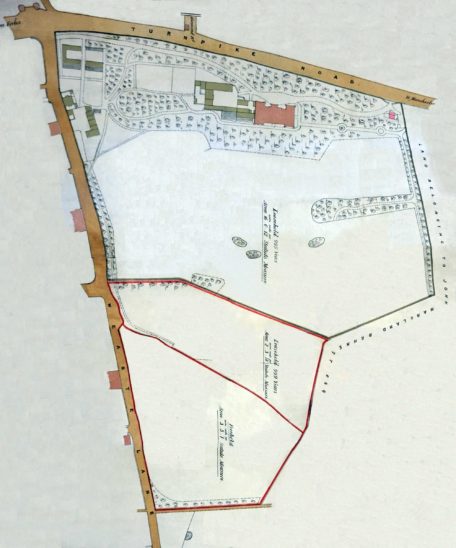

Dugdale’s Hart Hill of 1859 was a grand affair designed by the architect Walter Scott in the Elizabethan style. No images, photographs or elevations of this house have come to light but there are several plans and an estate layout dating from 1859. Walter Scott (1816-1884) was a Liverpool architect who built two houses for James Dugdale: Hart Hill and Wroxall Abbey. He also designed the first phase of St James, Hope which was partially funded by Dugdale. It is possible that Scott was also responsible for the design of Irwell Bank for John Dugdale which was situated on Eccles New Road. Photographs of this house have been mistaken for Hart Hill. Walter Scott was an architect of considerable expertise best known for his Clifton Park buildings in Birkenhead.
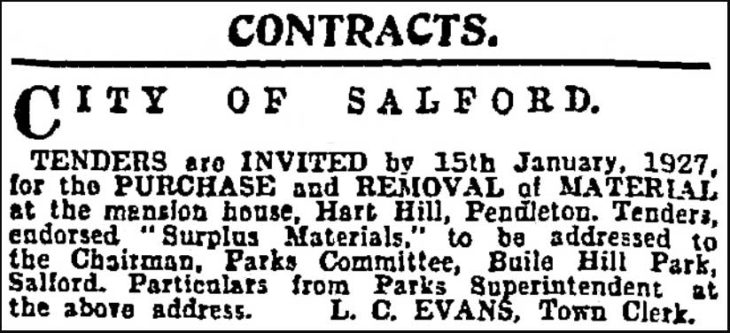
James Dugdale lived at Hart Hill for a short period of six years, moving to the Wroxall Abbey estate in 1865 where he spent the rest of his days. Hart Hill, its new mansion and grounds were bought by Thomas Hornby Birley in 1865 where he lived with his family until shortly before his death in 1885. A final resident, Louis Schwabe, lived at Hart Hill from 1885 until his death in 1922 when the estate and house were purchased by Salford Corporation who were determined to extend Buile Hill Park and resist housing development. They promptly emptied the 1859 house and it was demolished in 1926. Some of the building’s footprint survived however and was later uncovered in excavations in 2013 and 2015.

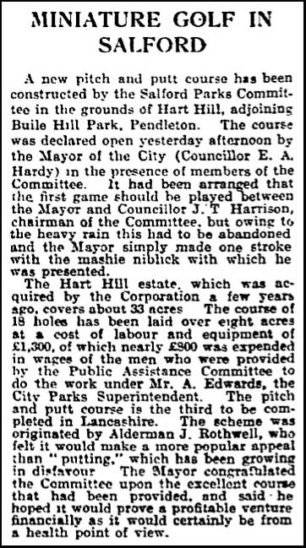




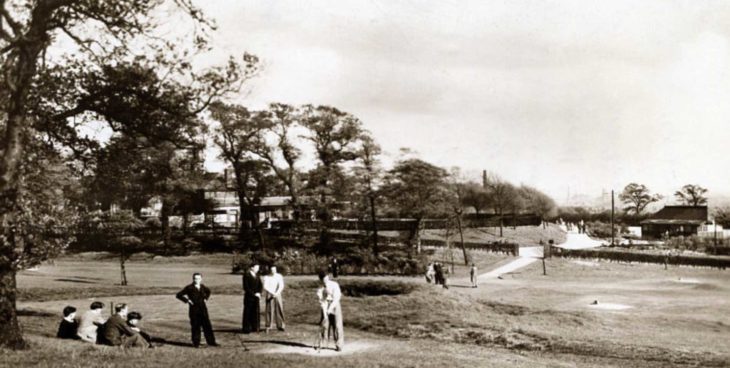
Hart Hill Timeline
1634 (July 13) Baptism at St Mary, Eccles of Mary daughter of Robert Bradshaw, Hartshill
1655 (June 28) Ralph Barlow de Hartshill buried at St Mary, Eccles
1663/64 Baptism at St Mary, Eccles of Robert son of Ralph Bradshaw de Hartshill
1665 Baptism at St Mary, Eccles of Thomas son of Ralph Bradshaw de Hartshill
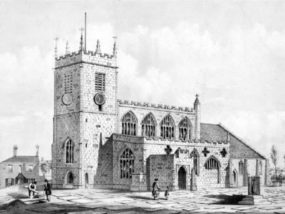
1667 Will of Ralph Bradshaw of Pendleton whose Executor and friend is his namesake Ralph Bradshaw of Hartshill. The testator’s wife is Rachell.
1728 (May 26) Baptism at St Mary, Eccles of Robert son of Ralph Bradshaw, Hartshill
1775 First mention of Thomas Percival in connection with Hart Hill.
1780s First meetings of the Manchester Literary and Philosophical Society are held at Hart Hill.
1783 (September) Thomas Percival leaves Hart Hill. The sale of the Hart Hill lease is advertised in the Manchester Mercury.

1780-1784 Land tax records show that Thomas Percival is renting the land and buildings at Hart Hill from John Fitzgerald; tax for the property is assessed at 16 shillings between these dates.
1785-1793 George Wakefield, probably ‘textile merchant, of Pendleton and Russia’ takes over the estate, renting Hart Hill which is assessed for tax of 13s 3 1/2d
1794 (December) Baptism of John Simpson’s son Francis at St Mary, Eccles
1794 First mention of John Simpson as proprietor of Hart Hill on land tax records
1798 John Simpson’s property at Hart Hill is assessed for a land tax of 13s 7d

1815 ‘Simpson Esq’ appears on the 1815 Hart Hill map
1822 Thomas Trueman is the proprietor of a cottage at Hart Hill
1823 The Simpson family have left Hart Hill by this date
1827 The date at which Thomas Trueman appears on land tax records as proprietor of the Hart Hill estate
1828 First mention of Thomas Trueman of Hart Hill in local newspapers
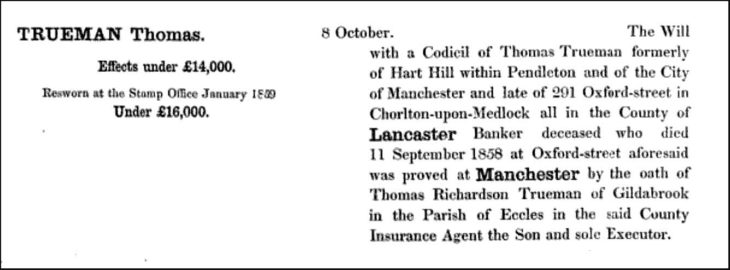
1841 Census returns – Thomas Trueman, merchant, Hart Hill
1852 Thomas Trueman opens the gardens and pleasure grounds at Hart Hill for a garden party for the Pendleton Chapel Sunday Schools.
1856 (December). An advert for sale of the Hart Hill contents belonging to Thomas Trueman appears in the Manchester newspapers.

1859 Design of the new Hart Hill mansion by architect Walter Scott for James Dugdale
1859 (February) Baptism of Helen Dugdale, Hart Hill – born December 1858
1860 (June) Baptism Herbert Crowe Dugdale, Hart Hill born February 1860
1861 Census returns for James Dugdale and family reveal that Dugdale, his wife and four children are living at Hart Hill with twelve servants (cook, nurses, scullery maid, butler, footman, groom, lady’s maid). Additionally a gardener is living at the lodge with his wife and child and a coachman. Two gardeners and an English teacher are living at 1 Weaste Lane, Hart Hill. The servants come from across the country.
1865 James Dugdale is included in the voters list for Wroxall Abbey
1865 First mention of Thomas Hornby Birley of Hart Hill in the newspapers
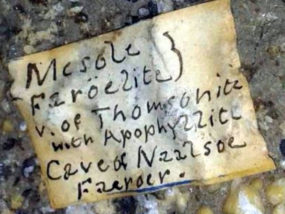
1871 Census returns record Thomas ‘Hugh’ Birley and family at Hart Hill with eleven servants. The gardener is living in the gatehouse and the coachman is resident at Hart Hill Cottages (1 Weaste Lane) with his family.
1881 Census returns have Thomas Hornby Birley and family at Hart Hill. Thomas is widowed and family members includes his three children, a daughter in law and grand-daughter with eight servants in the house and two coachmen and their families living in the lodge and coachman’s house on Weaste Lane.
1885 Thomas Hornby Birley dies having just left Hart Hill and taken up residence at Seedley Terrace with his two daughters.
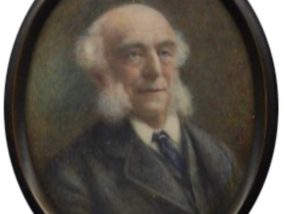
1886 Louis Schwabe and family take up residence at Hart Hill
1891 Census returns record Louis Schwabe and his family at Hart Hill
1901 Census returns show Louis Schwabe and family at Hart Hill
1911 Census returns show Louis Schwabe and family at Hart Hill

1912 Pendleton estate sale document gives details of the Hart Hill estate.
1916 Under the Town Planning Act Salford Corporation prepare plans to extend Bulie Hill Park.
1922 Death of Louis Schwabe
1922 (June) Salford Corporation open negotiations with the executors of Louis Schwabe to buy the 22 acre Hart Hill Estate.
1923 The Schwabe executors apply to erect 282 houses on the land which is refused planning consent as Salford Corporation require the land for recreation purposes. Louis Schwabe’s Executors are offered £600 per acre and £7000 for the house and buildings.
1924 A public inquiry is held at the Salford Town Hall at the request of the Schwabe executors resulting in arbitration.
1925 (October) Arbitration takes place between the Schwabe executors and Salford Corporation. The Schwabe executors estimate the value of the house and estate at £20,000. The purchase of Hart Hill and 22 acres of land by Salford is finally agreed at a price of £12,032.
1926 A motion put before Salford Corporation to build houses on the Weaste Lane and Eccles Old Road Road frontages of Hart Hill is proposed and defeated.
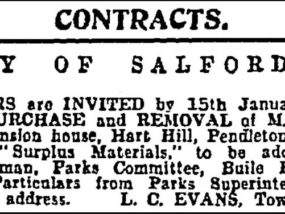
1926 Hart Hill mansion is demolished. The salvage raised £804 and many of the slates, bricks and timber are reused in the parks. A new entrance is erected at the corner of Weaste Lane and Eccles Old Road using the material from the original Hart Hill entrance. Weaste Lane and Eccles Old Road are widened. The SW gate is also constructed. The Robin Hood boiler from Hart Hill is moved to the Buile Hill greenhouse. The cottages on Weaste Lane are demolished during road widening.
A proposal from the Education Department to use Hart Hill for the purposes of an open air school is considered.
1927 Tenders sought for the removal of surplus materials at Hart Hill mansion. Two wrought iron park gates and perimeter ‘unclimable’ railings are provided for Hart Hill at a cost of £414.
1930 A pitch and putt course at Hart Hill is proposed to assist in the relief of the unemployed.
1932 Plans for an 18 hole pitch and putt course on a portion of Hart Hill land are prepared by Salford Corporation.
1933 Plans to make an educational garden are proposed and drawn up but not executed.
1934 The pitch and putt is officially opened by the Mayor of Salford, E A Hardy. The cost is £1,300 which is supplemented with money from the Public Assistance Committee.
1936 The work of laying out the remaining area of Hart Hill commences. The delay has been caused by financial constraints. The laying out of the Hart Hill land costs £4750.
1938 The Hart Hill extension to Build Hill Park is officially opened by Councillor J T Harrison. At the same time the Buile Hill cafe is also opened.

2013 First archeological investigation by Dig Greater Manchester takes place at Hart Hill.
2015 Flagship archaeological dig at Hart Hill takes place as part of the Dig Greater Manchester project.